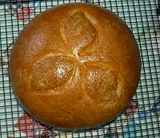I know several folks here have baked this recently, so hopefully I can get some clarification. Is the "barm" in this recipe in there strictly for flavor? I see further down the list that there's a good amount of instant yeast as well. The instructions say to remove the barm from the refrigerator 1 hour before using, but it doesn't say if it should be recently fed or not, and if so, how recently. I never stick my starter back in the fridge if I'm going to use it within a day or so, so I'm left puzzled! The only conclusion I can come to with this is that it's there strictly for flavor. The last time I fed my starter, a few days ago now, I stuck it immediately in the fridge as I wasn't expecting to use it for some time.
I just mixed up some extra sourdough the day before just as I would for any baking (unless a recipe calls for just a little which would be the same as a discard).
I'm pretty sure it was primarily for the flavour as there was instant yeast and being a one-day dough, the started wouldn't have had quite enough time to really get rising.
If you pull out your starter and it's still relatively active , then I'd presume it's good to go. If it's exhausted and is in dire need of a feed then I guess you need to do that first.
The Barm in this recipe starts with a seed culture and, I believe, the ingredients and the manner in which they are processed is essentially a flavoring element. The recipe doesn't ask us to feed the barm during the hour it rests outside the refrigerator and, in the absence of that instruction, I would not expect that feeding it should or would be either necessary nor wise. I followed the recipe religiously, step for step, which did not include feeding the barm and the result was spectacular.
[URL=http://s304.photobucket.com/albums/nn169/topturner/?action=view¤t=GreekCel3.jpg] [/URL]
[/URL]
[URL=http://s304.photobucket.com/albums/nn169/topturner/?action=view¤t=GreekCel10.jpg] [/URL]
[/URL]
That is a spectacular loaf of bread! If only I could get my sourdough loaves to get so much height!
Summer
I made the bread per the instructions, using my starter that had been fed a few days prior and then stuck in the fridge. The lift I got between the semi-active starter and the commercial yeast was amazing.
Oh... here's how it turned out :) http://theyeasticoulddo.net/2009/05/31/christopsomos-greek-christmas-bread/That is a gorgeous Celebration Bread Loaf Summer. Congrats ...
barm is used primarely as a starter. after you kept for a while the power is lost and your barm turns in a piece of ordinairy dough.
so you can, if you like, use it for flavor. most people just save a piece of their regular dough, keep it for a day or two and add it for flavor to their next batch of dough.
barm is made with yeast and is therefore not a sourdough.
bread should be a simple thing made from flour, water and salt. yeast can be used but is not needed. bottom line: bake your bread and if you like it be happy. there are so many breads as there are bakers.
mr. reinhart tries to make a big deal out of simple things. but when you need to sell books this comes with the territory, i guess.
don't get confused, bake what you like and while your bread cools let the brie get to room temp. and start digging in. prepare to gain some weight though.
page 66 (Copyright 2007) Peter Reinhart writes:
Peter is just human and used the term barm when he meant sourdough.
Mini
when I'm not thinking and referring to a Reinhart formula. Most of the time, if passing the recipe on I specify "100% hydration sourdough starter."
While I agree with the fact that Peter may have misused the term "barm" in The Bread Baker's Apprentice, I always try to use the same terms that the author used in his/her book when discussing issues specific to that publication in order to avoid confusion. Is it poor practice to use that approach? I'm new to this bread making thing and I'd like to avoid the inevitable faux paus as much as possible.